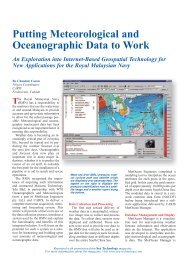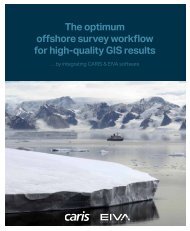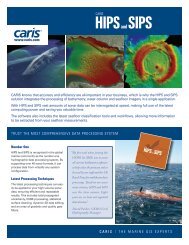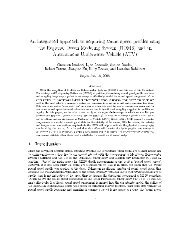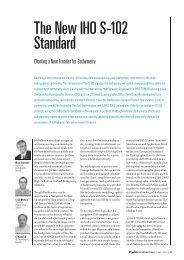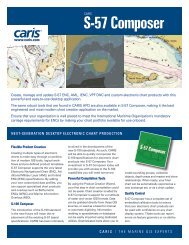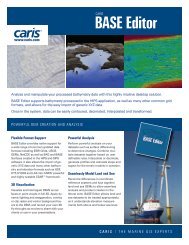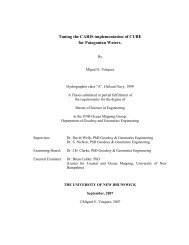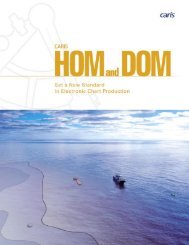APAALSE - Paper - Caris
APAALSE - Paper - Caris
APAALSE - Paper - Caris
- TAGS
- apaalse
- paper
- caris
- www.caris.com
You also want an ePaper? Increase the reach of your titles
YUMPU automatically turns print PDFs into web optimized ePapers that Google loves.
LawrenceApaalse<br />
ProjectCoordinator,<br />
Ghana National Continental Shelf Delineation Project (GNCSDP)<br />
MAKE A SPATIAL CONNECTION @ CARIS 2008<br />
12 TH INTERNATIONAL USER GROUP CONFERENCE & EDUCATIONAL SESSIONS.<br />
ABSTRACT<br />
SEPTEMBER 22 – 26. BATH, UK.<br />
The Government of Ghana instituted the National Continental Shelf Advisory Committee (NCSAC) in August 2006 under the auspices of<br />
the Ministry of Lands, Forestry and Mines, to collate data that would justify the commissioning of the Ghana National Continental Shelf<br />
Delineation Project (GNCSDP) in August 2007.<br />
This paper discusses the desktop study (DTS) phase of the project. The study was carried out by Robert van de Poll of Fugro Pelagos Plc.<br />
using the <strong>Caris</strong> Lots Software and public domain and some proprietary datasets to determine whether or not Ghana has a possible claim to an<br />
extended continental shelf under Article 76 of the United Nations Convention on the Law of the Sea (UNCLOS). It traces the events from<br />
the preliminary assessment of Ghana’s Article 76 initial potential of 1,440 km² to the current figure of 40,504 km², thanks to the <strong>Caris</strong><br />
Lots Software application.<br />
The DTS clearly identified the 1% sediment thickness and the 350 nautical mile (M) limit as the optimal formula and constraint lines for<br />
the delineation of the Outer Limits of the Continental Shelf (OLCS) of Ghana. It further recommends the acquisition of an extra 3,777 km<br />
of 2D seismic data for the preparation of a comprehensive submission.<br />
As there are no maritime boundary treaty lines within the study area, a hypothetical baseline model was generated from the World Vector<br />
Shoreline 2 (WVS2) dataset and in some cases, using the LANSAT TM 7 14.25 meters resolution Satellite Imagery. There were also 2<br />
small-scaled regional Nautical Charts and Orthophotos of the entire coastline.<br />
In line with Articles 74 and 83 of UNCLOS, adjacent boundaries between Ghana and neighbouring Cote d’Ivoire, Togo, Benin and<br />
Nigeria were also generated in the <strong>Caris</strong> Lots software using the median rule.
Introduction<br />
Ghana signed the United Nations Convention on the Law of the Sea on Dec 10 th 1982 and<br />
ratified it on March 20, 1983. In 1986 Ghana incorporated the UNCLOS provisions into<br />
domestic legislation and declared the continental shelf co-extending with the Exclusive<br />
Economic Zone (EEZ) and so pegged its outermost limits at 200 nautical miles (M) from the<br />
Territorial Sea Baseline (TSB). With the coming into force of the Scientific and Technical<br />
Guidelines of the Commission on the Limits of the Continental Shelf (CLCS), it became<br />
apparent that Ghana could make a submission for the extension of the continental shelf beyond<br />
200 M. This conviction was further motivated by the International Seabed Authority’s (ISA)<br />
report of 2000 which indicated that Ghana has an Extended Legal Continental Shelf (ELCS)<br />
potential of 8 billion barrels of oil equivalent.<br />
It is important to state that, while this desktop study was carried out by Robert van de poll of<br />
Fugro Pelagos, it has undergone dramatic transformations, including reviews by Prof. Karl Hinz,<br />
a retired Commissioner of the CLCS, Dr. Galo Carrera and Dr. Larry Awosika, both sitting<br />
Commissioner, and Dr. Lindsay Parson of Southampton Oceanography Centre, UK.<br />
Establishment of the Ghana National Continental Shelf Delineation Project (GNCSDP)<br />
In August 2006, the Minister of Lands, Forestry and Mines, put in place a National Continental<br />
Shelf Advisory Committee (NCSAC) to oversee to all aspects of the extension of the continental<br />
shelf of Ghana. Membership was drawn from a variety of stakeholders including the academia,<br />
research institutions and maritime agencies. Guided by the Scientific and Technical Guidelines<br />
and the Rules of Procedure of the CLCS, the Advisory Committee drew up a comprehensive plan<br />
that would see Ghana undertake a desktop study for the preparation of a submission for the<br />
extension of the continental shelf of Ghana. Consequently, the GNCSDP was commissioned on<br />
August 30 th 2007, along with the formation of three standing Committees; the Ministerial<br />
Oversight Committee (MOC), the Steering Committee (SC) and the Technical Core Group.<br />
The MOC is made up of Ministers from the Ministry of Education, Science & Sports, Ministry of<br />
Lands, Forestry & Mines, Ministry of Energy, Ministry of Foreign Affairs, Regional Integration<br />
& NEPAD (New Partnership for Africa Development), Ministry of Justice & Attorney General<br />
Department, Ministry of Finance & Economic Planning, Ministry of National Security, and a<br />
representative of H. E. the President of the Republic of Ghana.<br />
The Steering Committee and the Technical Core Group are made up of representatives from the<br />
Geological Survey Department, Survey Department, Ghana National Petroleum Corporation<br />
(GNPC), Ministry of Justice & Attorney General Department, Ministry of Lands, Forestry &<br />
Mines, Ministry of Foreign Affairs, Regional Integration & NEPAD, Ministry of Finance &<br />
Economic Planning, Regional Maritime University and the University of Ghana.<br />
Desktop study (DTS)<br />
The delineation of the continental shelf of any coastal State beyond 200 nautical miles and the<br />
subsequent preparation of a submission involves several stages of scientific, legal and diplomatic<br />
2
work. The preliminary stage which normally involves scanning and desktop study is the subject<br />
of this paper.<br />
The preliminary assessment of data and metadata necessary for the DTS of the Ghana continental<br />
shelf project was carried out by the Geological Survey of Denmark and Greenland (GEUS), in<br />
consultation with NCSAC, in March 2007, using mainly seismic data supplied by the national oil<br />
company (GNPC). The seismic, which was scanned in Kingdom Suite, revealed that the FOS<br />
could only be located in selected areas, thus identifying some data gaps (Figure 1).<br />
The Project later received a report prepared by Robert van de Poll, of Fugro Pelagos Inc. under<br />
the NEPAD sponsored African Shelf Project, initiated by Senegal and the Council for<br />
Geoscience of South Africa (CGS) using <strong>Caris</strong> Lots and public domain datasets. This assessment<br />
includes an earlier report (Report No. 2003-0233) on preliminary continental shelf assessment of<br />
coastal African States by Dr. S. Perritt in which Ghana was quoted as having the potential to an<br />
Extended Legal Continental Shelf of the order of 1,440 km² based on the 1% sediment thickness<br />
formula (Figure 2). This report which considered the area of relevance from Sierra Leone to<br />
Gabon, assumed normal baselines from the World Vector Shoreline 2 (WVS2) database except<br />
for Gabon where straight baselines were applied. The public domain data employed in this report<br />
are mainly Digital Chart of the World (DCW), WVS2, 2-minute gridded bathymetry (ETOPO-2)<br />
and the NGDC gridded sediment thickness data.<br />
At this point, it is essential to mention that no in-house proprietary data were included in this<br />
assessment, giving rise to the hope that the extension area could be improved with the inclusion<br />
of these datasets. The report also conclusively recommended the Gardiner Line and the 350<br />
nautical miles limit as the optimal formula and constraint lines respectively for Ghana.<br />
SEISMIC DATABASE<br />
FOS outside existing seismic<br />
coverage, more data needed<br />
FOS can be determined<br />
from existing seismic data in<br />
this region and towards the<br />
Ivory Coast<br />
9<br />
3
Figure 1: Proprietary data available in GNPC showing seismic coverage of the entire coast. The<br />
yellow ovals are areas where the FOS could be located as mapped by GEUS &<br />
NCSAC, March 2007.<br />
Figure 2: This figure shows the potential extension area of 1,440 km² for Ghana (red) as depicted<br />
in Report No. 2003-0233<br />
The GNCSDP considers the preliminary assessment contained in Report No. 2003-0233 as the<br />
qualifying criteria for the Test of Appurtenance (TOA) under the requirements of Article 76.<br />
Based on this, Robert van de Poll, Fugro Pelagos, was contracted to carry out the desktop study,<br />
in consultation with the GNCSDP, under the following scope of work:<br />
• Define the Territorial Sea Baseline (Normal Baseline) by generating base points from UK<br />
Hydrographic Nautical Charts, Russian Nautical Charts, recently acquired 0.5 m resolution<br />
Orthophotos of the entire coastline of Ghana and direct Field Observations.<br />
• Delineate adjacent boundaries between Ghana and Cote d’Ivoire, Togo, Benin and Nigeria.<br />
• Measure the 200 nautical mile limit and the 350 M constraint line from the baseline<br />
• Locate the FOS at the maximum change in gradient at the base of the slope.<br />
• Choose the points where the sediment thickness is 1% of the distance to the FOS<br />
• Determine the approximate extension area<br />
• Recommend any extra data needs for the preparation of the submission to the CLCS<br />
Legal Limits<br />
The 1986 Maritime Zones (Delimitation) Law, PNDC Law 159, which incorporated the<br />
UNCLOS provisions into Ghana’s domestic legislation, declared the following Maritime Zones<br />
measured from the Territorial Sea Baseline (TSB):<br />
• A Territorial Sea of 12 M,<br />
• A Contiguous Zone of 24 M,<br />
• An Exclusive Economic Zone (EEZ) not exceeding 200 M, and<br />
4
• A Continental Shelf of up to 200 M.<br />
By the same legislation, the Normal Baseline was declared as the official Territorial Sea Baseline<br />
as published in the United Nations ‘Table of Claims to Maritime Jurisdiction’, May 2008.<br />
Territorial Sea Baseline<br />
To proceed with the desktop study, a base map of the area (Figure 3) had to be generated. The<br />
2006 National Geospatial Agency (NGA) WVS2 dataset was used to mimic the coastline at an<br />
approximate scale of 1:75000 and an accuracy of ±100 m. This new NGA WVS2 dataset was<br />
collected from present-day LANDSAT TM7 Satellite Imagery (14.25 m resolution, accuracy ±50<br />
m, September 2003).<br />
It must be pointed out that published base points of coastal States in the study area were not<br />
available. However, Cote d’Ivoire and Nigeria have legal legislations for the use of both straight<br />
and normal baselines while Togo and Benin have legislations for the use of normal baselines as<br />
the TSB. For this reason, ‘hypothetical’ base points and baselines were produced for respective<br />
adjacent coasts by digitizing the straight and normal baselines in <strong>Caris</strong> Lots with the help of<br />
nautical charts, satellite imagery and orthophotos.<br />
Strenuous efforts were made to generate base points for the Ghana TSB. Initially, two United<br />
Kingdom Hydrographic Office Nautical Charts Nos.1383 and 1384, published on July 11, 2004<br />
and May 12, 2005 respectively, were used. They are both regional Nautical Charts of 1:350,000<br />
scale, showing generalized coastline with some isolated low water line information (Figure 4).<br />
No datum was supplied for these charts and a note on the charts themselves cautions their<br />
accuracy. Therefore, a resort was made to three larger scale Russian Nautical Charts (Chart 3500<br />
in 1:150000, Chart 35001 in 1:150,000 and Chart 35005 in 1:50000). Recently acquired 111 0.5<br />
m resolution orthophotos were also supplied by the Survey Department of Ghana to improve the<br />
quality of the base points.<br />
In the final analysis, 335 base points were computed as geographic coordinates in WGS84<br />
Datum and are now being edited to be submitted to the United Nations for publication and also<br />
to be used in adjacent maritime boundary delineation neighbouring coastal States (Cote d’Ivoire<br />
to the west, and Togo, Benin and Nigeria to the east).<br />
Out of the 335 base points, 28 were collected from the Russian Nautical Charts (see Figure 5 for<br />
examples). The remaining 307 were collected from the Orthophotos, examples of which are<br />
shown in figures 6 & 7.<br />
5
Figure 3: Base Map of study area showing World Vector Shoreline 2 coastline in green.<br />
Figure 4: Example of the UKHO Nautical Charts showing the coastline at Cape Three points.<br />
6
Figure 5: Russian Nautical Charts (1:150000) of the coastline of Ghana showing low water<br />
elevations and two base points.<br />
Figure 6: Examples of the 0.5 meter high-resolution Orthophotos showing interpreted normal<br />
baseline (red) and 2 base points (red dots).<br />
7
Figure 7: Examples of the 0.5 meter high-resolution Orthophotos showing interpreted normal<br />
baselines (red) and 3 base points (red dots). In this figure, numerous offshore low<br />
water elevations (rocks and reefs?) can clearly be seen.<br />
Maritime Boundaries<br />
Ghana shares maritime space with Cote d’Ivore to the West and Togo, Benin and Nigeria to the<br />
East. Maritime boundary treaty lines (bi- or multi-lateral agreements) for these States are not<br />
available. For this reason, the United Nations’ best practices for Law of the Sea methodologies<br />
were followed and a “hypothetical” set of Geographic Coordinates were generated in <strong>Caris</strong> Lots<br />
as the base points. This baseline information was then used to produce “hypothetical” maritime<br />
boundaries between Ghana and her neighbours using the Equidistance Method (Figure 8).<br />
Discussions are now underway with a view to signing maritime boundary treaties with Cote<br />
d’Ivoire and Nigeria as part of the submission process. Those boundaries relating to Togo and<br />
Benin are yet to be considered as they have not responded to Notes Verbale sent to them last<br />
year.<br />
8
Figure 8: Diagram detailing the baselines, normal, (blue), straight (red), “hypothetical” maritime<br />
boundary lines (orange), and the 200 M EEZ (red, offshore).<br />
The Outer Limits of the Continental Shelf beyond 200 M<br />
As already stated, the determination of the outer limit of the continental shelf of Ghana beyond<br />
200 M is a straight function of the 1% sediment thickness line (which depends on the FOS) and<br />
the 350 nautical miles constraint line.<br />
Article 76 paragraph 4b states that “…in the absence of evidence to the contrary, the foot of the<br />
continental slope shall be determined as the point of maximum change in the gradient at its<br />
base...”.<br />
Therefore, sediment thickness analysis of the sub-surface to determine the 1% sediment<br />
thickness points relative to the Foot of the Slope (FOS) was carried out. The bathymetric echosounding<br />
information compiled in the determination of the FOS was primarily collected from the<br />
GEODAS database of the National Geophysical Data Center (NDGC) (Figure 9). Selected<br />
bathymetric profiles were assembled across the continental margin of Ghana from the ETOPO2<br />
9
Digital Atlas for the purpose of illustrating the general slope morphology and selecting optimal<br />
FOS points.<br />
Figure 9: Result of the GEODAS database bathymetric & geophysical cruise survey search in the<br />
Gulf of Guinea by institution source.<br />
The FOS profile line can be drawn in the <strong>Caris</strong> Lots software. Each profile line was analyzed<br />
using the underlying Raster bathymetric data sources (ETOPO2, and GEBCO1) and the<br />
GEODAS ship tracks. In all, 65 lines were chosen from four different GEODAS databases to<br />
cover the entire continental margin and the abyssal plain. The Douglas-Peucker filter from the<br />
<strong>Caris</strong> Lots software’s ‘Foot of the Slope Tool’ which applies a linear approximation of<br />
bathymetric profiles was applied to identify the FOS markers.<br />
10
A review of the over 700 2D SEGY lines supplied by the Ghana National Petroleum Corporation<br />
(GNPC), showed that some of these lines could well be used to locate the FOS positions in some<br />
areas. Unfortunately, these data were not incorporated into this study due to lack of time.<br />
The 1% sediment thickness Formula Line (Gardiner Line)<br />
The <strong>Caris</strong> Lots software was used to calculate the sediment thickness position at each point along<br />
the FOS profiles and 1% sediment thickness points were determined. The individual 1%<br />
sediment point markers were then connected together to form the 1% sediment thickness line<br />
commonly referred to as the Gardiner Line (Figure 10).<br />
Figure 10: The Gardiner Formula line showing SED Profile lines closely spaced yellow lines)<br />
and the individual FOS markers (yellow and black circles). The black circles are<br />
from the coarse-gridded sediment model.<br />
The individual 1% sediment markers (black triangles on the yellow lines) are the individual<br />
results of the 1% sediment positions. In this DTS, two individual sediment models were used and<br />
these two models produced different results. The inner row of 1% sediment thickness came from<br />
the analysis of the Fine Sediment Raster Model; the outer row of 1% sediment points came from<br />
11
the second sediment - Coarse Raster Model. It must be stated that these analyses are for<br />
demonstration only as gridded datasets are not accepted by the Commission for submissions.<br />
Establishment of the 350 Nautical Miles Limit<br />
As already stated the constraint line was computed for only the 350 M as this portion of the<br />
Eastern Equatorial Atlantic has a rather narrow continental shelf and a very steep continental<br />
slope. The 2,500 meter isobath is very close to shore, and in no location of the study area did it<br />
protrude seaward of the 350 M (Figure 11).<br />
Figure 11: This figure illustrates the positions of the 2,500 m isobath (light grey line), the 2,500<br />
m + 100 M constraint line (light green, offshore) and the 350 M line (dark blue, offshore).<br />
Delimitation of the Potential Extension area<br />
Based on the analyses of the two sediment datasets discussed above, two sets of results were<br />
computed. The Fine Sediment Datasets show that Ghana’s extended continental shelf lies only to<br />
the eastern portion of the study area with an approximate area of 6,148 km² (Figure 12).<br />
12
Figure 12: Results of the Fine Sediment Dataset showing the continental shelf extension area of<br />
approximately 6,148 km² (red filled).<br />
The second set of results was produced from the Coarse Sediment Datasets, which shows an<br />
UNCLOS Article 76 extension covering the entire offshore beyond the 200 M of approximately<br />
40,504 km² (Figure 13).<br />
13
Figure 13: This figure shows the potential UNCLOS Article 76 area of approximately 40,504<br />
km² (red filled) based on the coarse-gridded sediment data.<br />
Survey Planning<br />
It has been noted that several East-West prominent linear Fracture Zones are present and very<br />
well documented in this transform margin setting. This is critical from an analysis point of view<br />
and for planning purposes. If these linear trends are seen to “pop through” the sediments on the<br />
seabed, the continuity of the sediment plume seaward of the FOS, as required by CLCS, cannot<br />
be established.<br />
Due to these uncertainties, a multi-variate approach to seismic data planning was adopted. Two<br />
seismic survey plans have been suggested. Plan A consists of 10 proposed lines spaced 50 M<br />
apart with a total of 4,189 km. Survey plan B consists of 20 proposed lines, spaced at 30 M with<br />
a total of 6,529 km. These plans were contingent on the continuity of sediments and were<br />
designed such that the survey could be called off after a minimum of 3,777 km. These plans were<br />
then run by Prof. Karl Hinz, courtesy the Commonwealth Secretariat, who felt that only three<br />
seismic lines, each 300 km long, from the Ghanaian slope into the eastern potential extension<br />
area and a maximum of three tie-lines, each about 110 km long, i.e. a total of about 1,250 km,<br />
are sufficient (Figure 14).<br />
14
However, the GNCSDP, desirous to maximize territorial gains, has advised the government to<br />
tender for a minimum of 2000 km that would allow for an additional strike line to test the<br />
western corridor of our basin (Figure 14).<br />
In line with this, several quotations have already been received, including those from SeaBird<br />
Exploration, TGS-NOPEC, GEMS, etc. These are now being evaluated and the field work is<br />
scheduled for November.<br />
15
Figure 14: Final seismic outline for tender. Courtesy Professor Karl Hinz.<br />
16
Conclusions and Recommendations<br />
The results of the examinations and analyses of available public and proprietary data sources<br />
allow the following conclusions to be made:<br />
• Ghana can meet the test of appurtenance to extend the outer limit of the continental shelf<br />
beyond 200 nautical miles;<br />
• the determination of the outer limit of the continental shelf beyond 200 M is a function of<br />
one formula line, the 1 per cent sediment thickness line, and one constraint, the 350 M line;<br />
• the potential extended continental shelf area to the east probably overlaps with an extended<br />
continental shelf area to which a neighbouring State, especially Nigeria, may want to lay<br />
claim under UNCLOS. More work is required to ascertain this which would be processed as<br />
part of the submission.<br />
• the acquisition of some new geophysical data, in particular multi-channel seismic reflection<br />
data appears essential in order to establish continuity of the sediments between the foot of the<br />
slope and the outer limit points.<br />
• in order to meet the time line of May 13, 2009 for submission, on-board processing, using the<br />
<strong>Caris</strong> Lots and the geophysical and geological interpretation Kingdom Suite Softwares, have<br />
been designed to simultaneously process and interprete real time data.<br />
17
BIBLIOGRAPHY<br />
Divins, D.L., NGDC Total Sediment Thickness of the World's Oceans and Marginal Seas, Gulf<br />
of Guinea.<br />
http://www.ngdc.noaa.gov/mgg/sedthick/sedthick.html<br />
GEODAS. Geodas marine geological and geophysical data from U.S. Department of Commerce,<br />
NOAA and NGDC.<br />
Laske, G. and G. Masters (1997). A Global Digital Map of Sediment Thickness, EOS Trans.<br />
AGU, 78, F483.<br />
United Nations (1999a). Scientific and Technical Guidelines of the Commission on the Limits of<br />
the Continental Shelf. CLCS/11, 13 May 1999.<br />
Graham Davis, 1989. Geological and Tectonic Framework of the Republic of Ghana and<br />
Petroleum Geology of the Tano Basin, Southernwestern Ghana. Vol. 1 & 2.<br />
Geo-Marine Letters, Vol. 17, No. 1, 1997, p1-19, 31-86<br />
Division of Ocean Affairs and Law of the Sea Table of claims to maritime jurisdiction, May 28,<br />
2008.<br />
18



